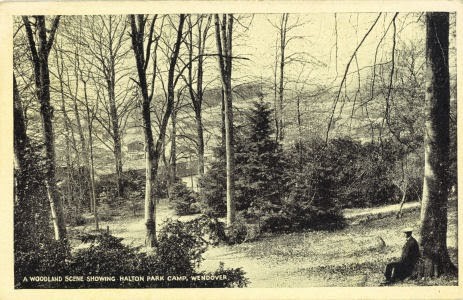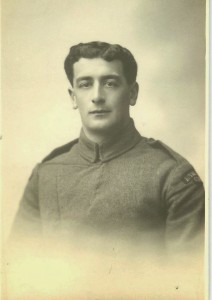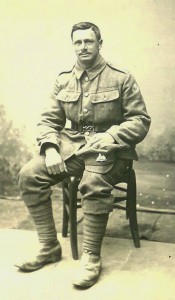Posted on November 19, 2015, 9:30 pm By John Proctor

John Ives and his elder brother James began the War doing the same job at the same place.
Alfred De Rothschild the owner of Halton Hall, near Wendover, Bucks offered his estate to the War Office for military training. The 21st Division, one of the components of Lord Kitchener’s Third New Army, was concentrated in the vicinity of Tring, Hertfordshire in the autumn of 1914 and occupied Halton Park before the onset of winter drove them into local billets.
The Ives brothers lived in the village of Long Marston about six miles from Halton Park via Wilstone and Aston Clinton. The construction of huts must have been an attractive employment opportunity for local carpenters and the brothers worked on the project from 1914 onwards – they would earn a bonus of half-a-crown for every hut completed. James and John specialised in cutting match-boarding and held the record for the greatest number of boards sawn in a day. They were apparently among the last remaining carpenters of 2000 men who worked on the construction of Halton Camp, which, by 1916, accommodated nearly 20,000 infantrymen in wooden huts and tents.
Subsequently Johnny Ives went across to France to build huts there and James joined the army.
| Johnny Ives in RFC uniform |
John spent three and a half years in France, including 12 months serving in the Royal Flying Corps. There his woodworking skills were employed in repairing and converting a single-seat aeroplane into a twin-seater so that his CO could ‘take a certain duchess for a spin’.
James joined the army in 1916 and in the spring of 1917 was attached from the Hertfordshire Regiment to the ‘D’ Company 8th Lincolnshires Regiment. On May 22nd 1918 ‘tidings’ came from the War Office that Private Ives had been killed on or about 31st July 1917 in Belgium during the third Battle of Ypres.
A letter from the ‘British Red Cross and Order of St John Enquiry Department for Wounded and Missing’, dated 21st February 1918 confirmed that it was likely that Private Jas. Wm. Ives 235254, D Coy. 8th Lincolns was dead.
‘With reference to your enquiry regarding the above, I write with deepest regret to inform you that we have just received the following sad report from Pte. J H Dunn, 43324, D Coy. 8th Lincolns, a prisoner of war, who reports as follows:-
‘The last time I saw Pte. Jas. Wm. Ives was early in the morning, say 8 o’clock; he was wounded, tried to get back, but I think, well most sure, he was sniped and killed.’
We fear his conclusion is probably correct as had Pte Ives survived we feel certain that he would have been heard of long before this.
Yours faithfully,
For the Earl of Lucan’.
On 8th July 1917 8th Battalion Lincolnshires, a component of the 63rd Brigade together with 8th Battalion Somerset Light Infantry; 4th Battalion Middlesex Regiment; 10th Battalion York & Lancaster Regiment; 63rd Machine Gun Regiment and 63rd Trench Mortar Battery; joined the 37th Division, part of the Second New Army, to later take their part in the Battle of Pilckem Ridge in the Third Battle of Ypres.
The Third Battle of Ypres was a series of small battles which became synonymous with the slaughter of the Western Front. The intention for the opening stage of the battle was to take objectives in and around the village of Pilckem, a few miles to the north of Ypres. The village was situated near a ridge which gave a commanding view of the British line and so it was important that it was taken both to deny the enemy their excellent vantage point and to give the British an observation point across the German rear, which would give them a significant tactical advantage.
The Allied artillery bombarded the German lines with more than four million shells between July 16th and the 31st in preparation for a forthcoming advance. The attack was to begin at dawn on 31st July. The action commenced at 3.50am in mist and heavy rain and by the end of the day, with most of the objectives having been taken, allied casualties numbered 15,000.
The History of the Lincolnshire Regiment records the following:- ‘At 3.50am on 31st July, the attack began. ‘D’ Company of the Lincolnshire being detailed to form the defensive flank on the right of the 4th Middlesex from June and July Farms. The right company of the Middlesex advanced and gained its objective, and, at 4.30am two platoons of the supporting company went through to reconnoitre and clear Bab Farm. It was at this stage that the leading platoon of the 8th Lincolnshire, then engaged in forming the defensive flank, was drawn into the fighting. Some stiff close-quarter fighting then ensued, and heavy casualties were inflicted on the enemy, but the attackers were hard-pressed. Again and again they tried to send runners back for assistance but they were shot down. Runners sent forward from the reserve company also failed to reach the attackers and the brigade narrative ends the account of the gallant party of Middlesex and Lincolnshire with the words: “This party fought it out where they were until they were all either killed or wounded”.’
Pte Jas Wm Ives, D Coy 8th Lincolnshire
No comments yet Categories: John Proctors Blog


